Development of HRIS: A Comprehensive Guide 2025
Discover the future of HR with our 2025 guide on development of HRIS; key steps, trends, metrics, and how CandorIQ enhances your HR system’s impact.
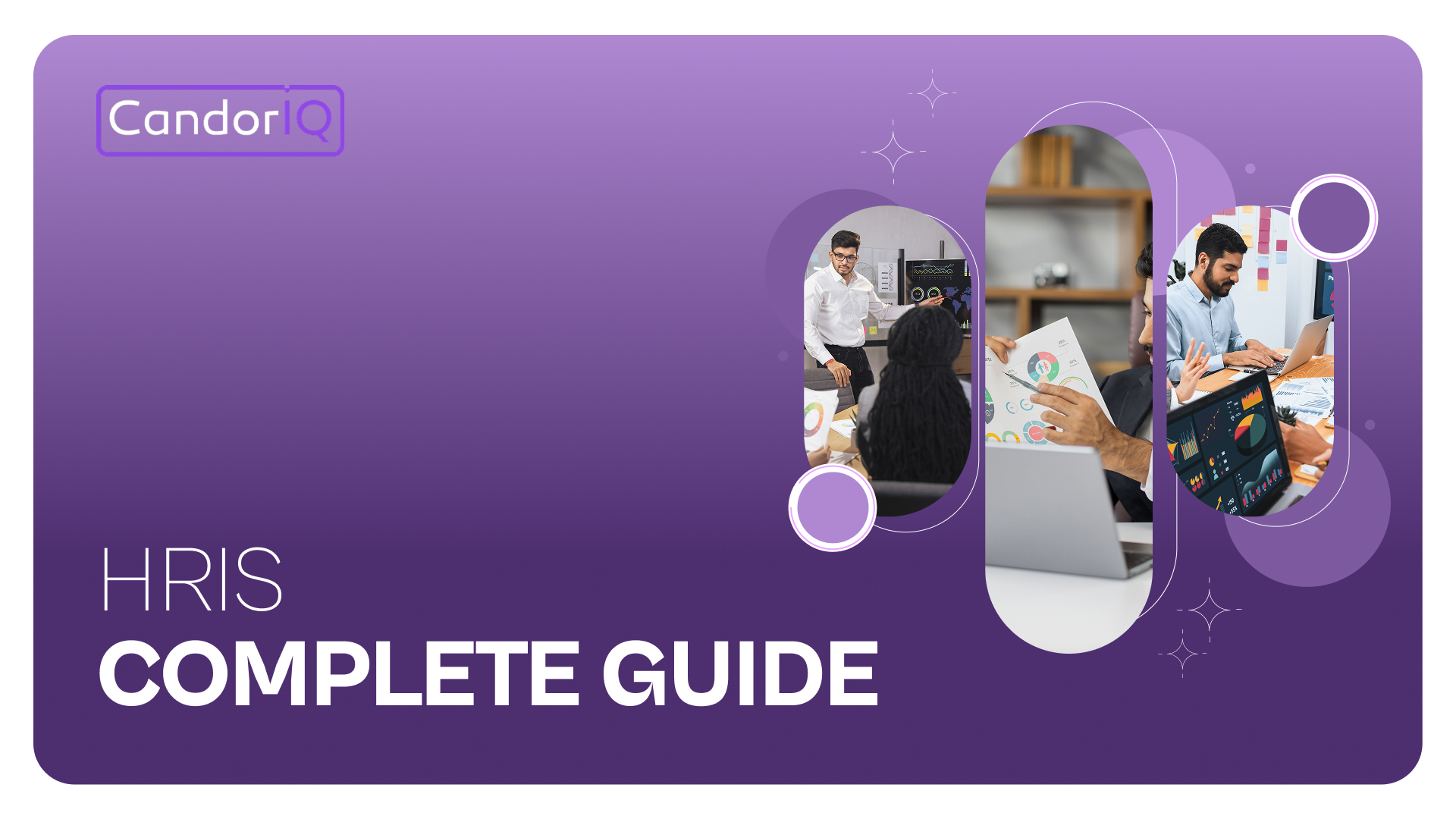
The development of HRIS (Human Resource Information Systems) is no longer just an IT project, it’s a strategic imperative for businesses navigating workforce complexities in 2025. If your HR teams are juggling fragmented tools, delayed reporting, or clunky processes, you're not alone. These inefficiencies not only hinder operations but stall growth. We understand how overwhelming it can be for mid-sized and rapidly scaling organizations to manage compensation and headcount planning with limited HR resources and distributed teams.
This comprehensive article will walk you through the modern development of HRIS, from aligning with business goals to integrating advanced tools like CandorIQ for compensation governance, analytics, and planning. You’ll learn how to future-proof your HR infrastructure and turn it into a data-driven engine that powers smarter, faster decisions.
TL;DR:
- HRIS is strategic, not operational. It's critical for real-time decisions and global workforce agility.
- Follow a 7-phase HRIS framework. From strategy to optimization, each step drives ROI.
- CandorIQ adds intelligence. It powers comp governance, attrition prediction, and planning.
- Track what matters. Focus on adoption, data quality, and impact on business KPIs.
- The future is now. AI agents, skills-based systems, and finance-HR integration are must-haves.
What Is HRIS & Why Its Development Matters
Human Resource Information System (HRIS) is your central nervous system for managing people operations. It consolidates employee data, automates HR tasks, and provides real-time visibility into your workforce.
But the development of HRIS isn’t just about deploying software, it’s about creating a scalable, secure, and strategy-aligned foundation that evolves with your organization’s needs.
Understanding HRIS in the Modern Context
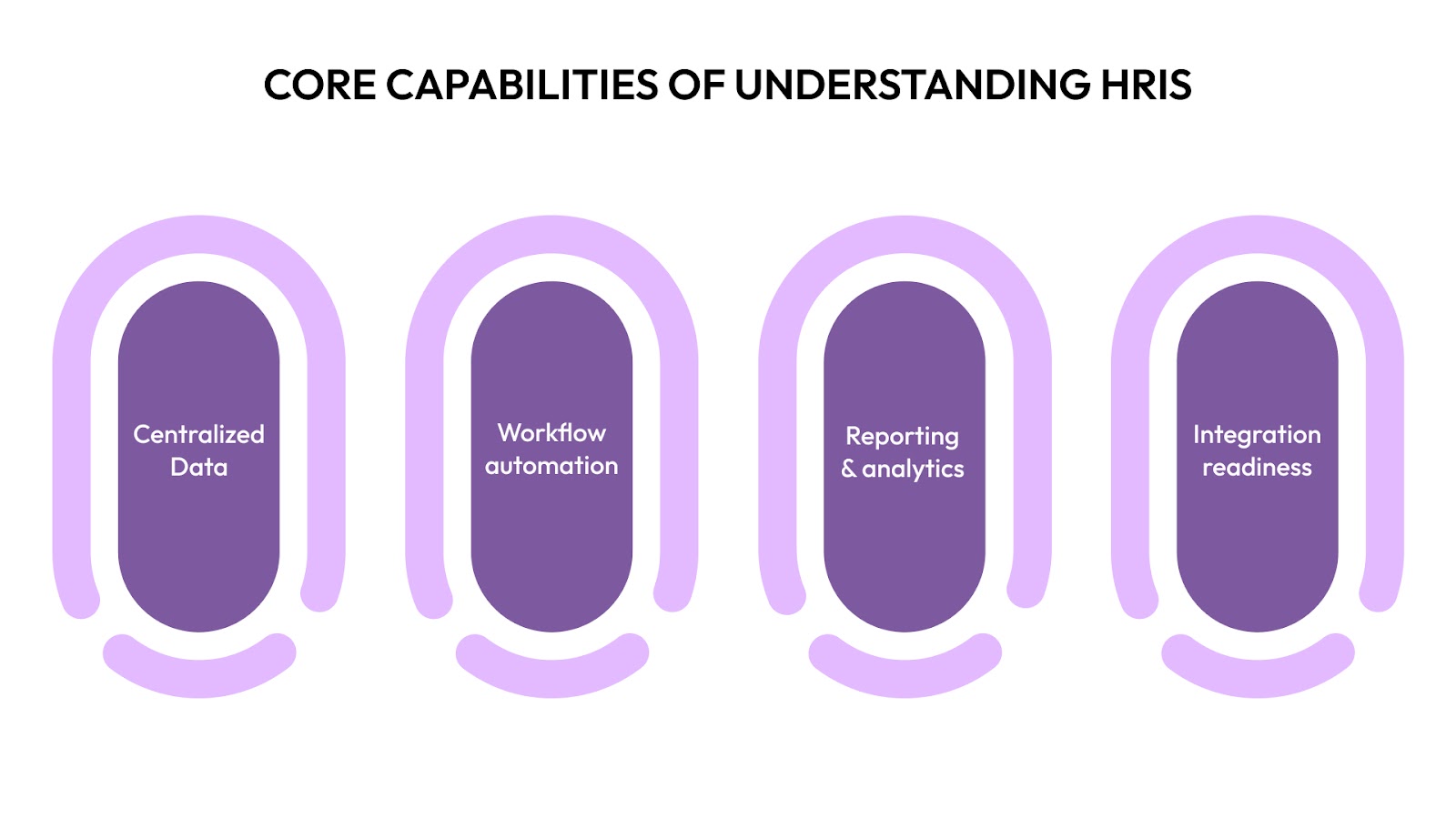
An HRIS today goes far beyond storing employee records. It connects core HR functions, like payroll, benefits, onboarding, time tracking, and compliance, with analytics and decision-making tools.
Core capabilities include:
- Data centralization: One source of truth for employee profiles, job roles, compensation, and performance.
- Workflow automation: Reduces manual overhead in tasks like approvals, record updates, or compliance tracking.
- Reporting & analytics: Empowers HR, Finance, and executive teams with actionable insights.
- Integration readiness: Links with ATS, payroll, learning management, and tools like CandorIQ to close process gaps.
Why HRIS Development Is Business-Critical in 2025
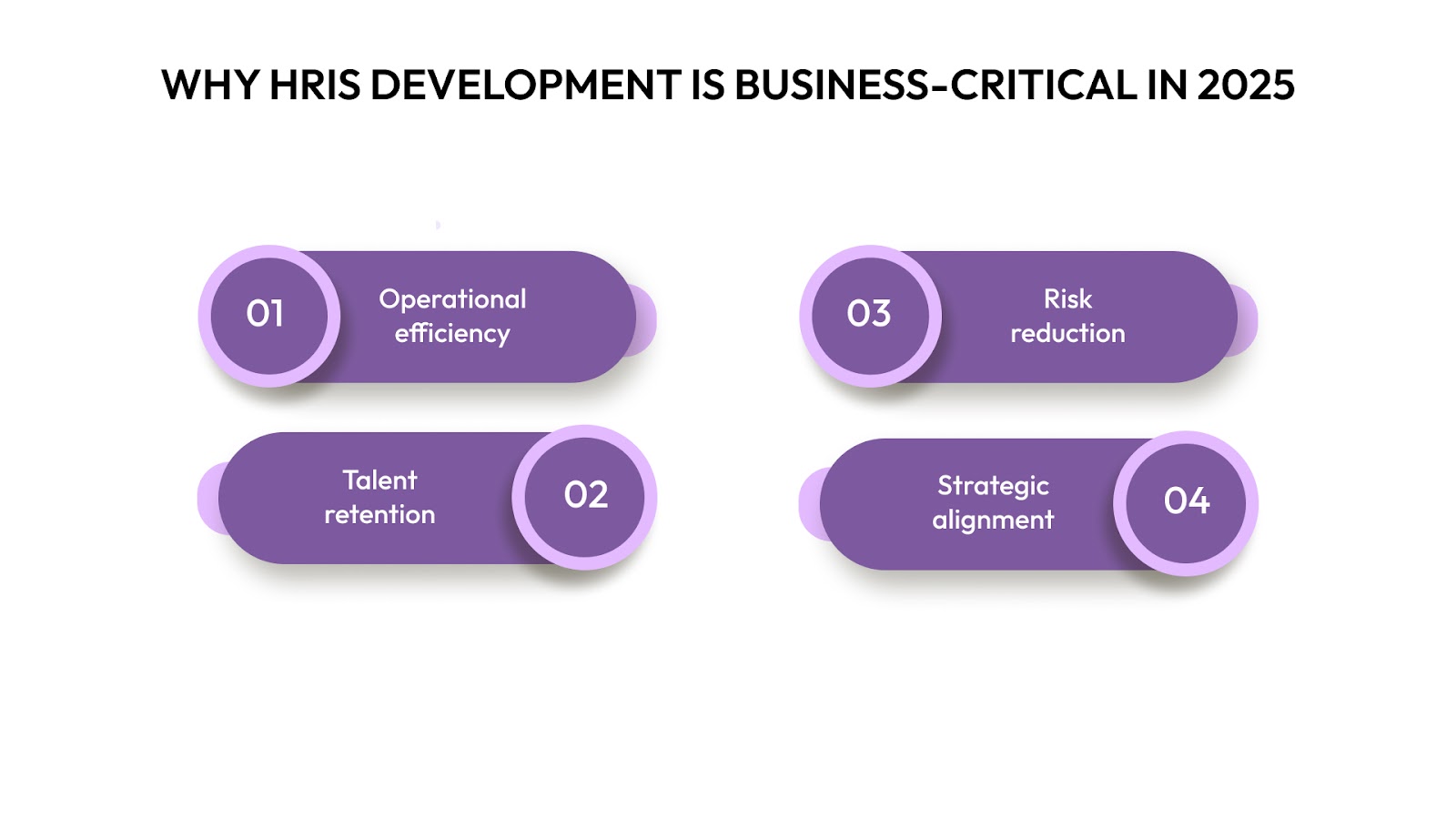
The stakes are higher than ever. As hybrid work expands and teams scale globally, disconnected tools create blind spots and compliance risks. A well-developed HRIS helps you stay ahead.
Here’s why the development of HRIS is essential:
- Operational efficiency: Companies with mature HR tech stacks report higher productivity.
- Talent retention: A streamlined HR experience increases employee satisfaction.
- Risk reduction: Automating compliance tasks helps reduce errors and penalties tied to payroll, DEI reporting, and data privacy.
- Strategic alignment: A customizable HRIS enables advanced features like compensation governance, headcount planning, and attrition forecasting, especially when integrated with platforms like CandorIQ.
The Evolution: From Static Systems to Dynamic Intelligence
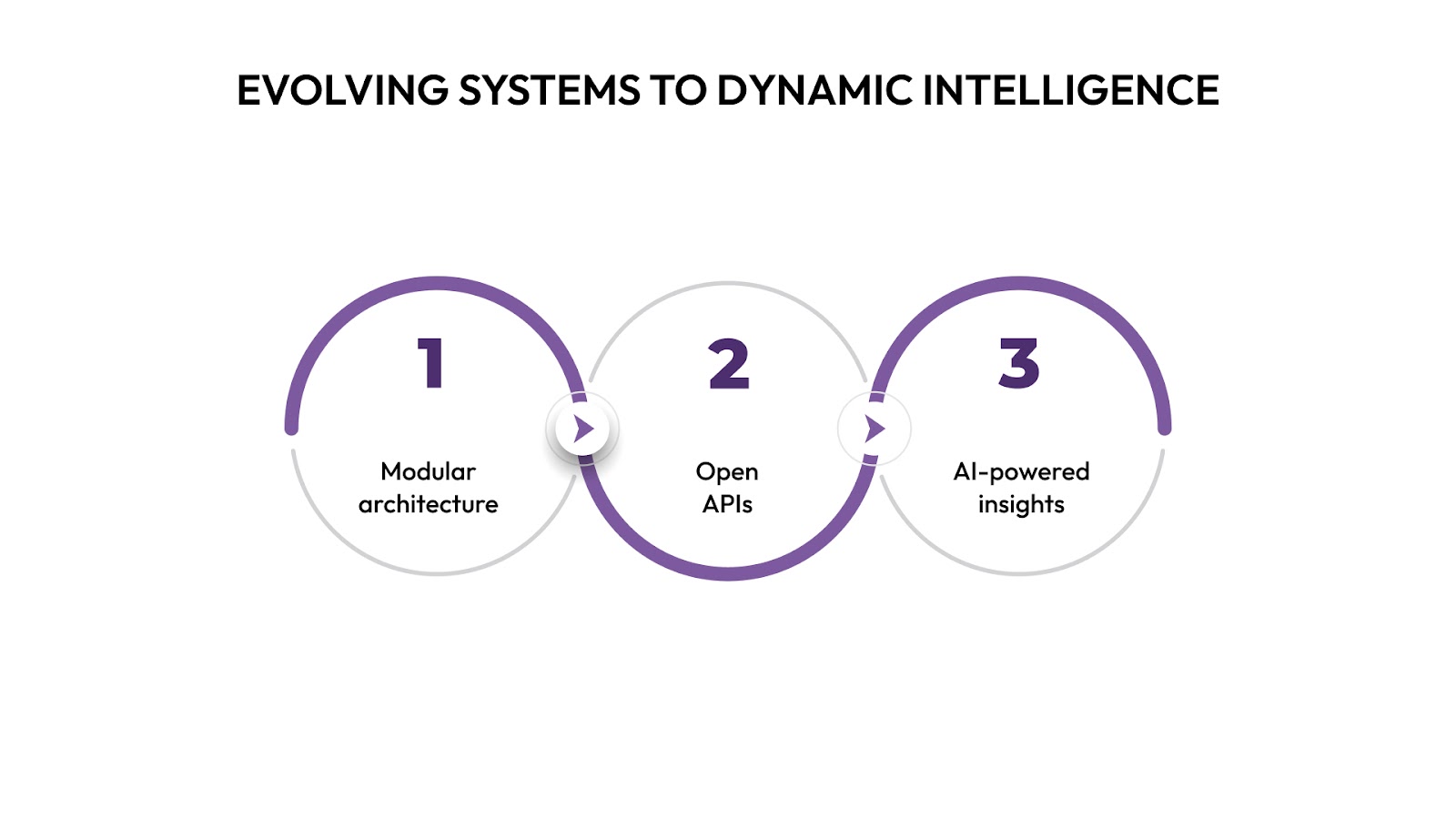
Legacy HRIS platforms often lack adaptability, forcing teams into static workflows. Modern HRIS development emphasizes:
- Modular architecture: Build what you need, when you need it.
- Open APIs: Connect and scale your ecosystem without rework.
- AI-powered insights: Predict attrition, optimize pay, and model headcount with real-time intelligence.
A forward-thinking HRIS is a strategic partner that when paired with platforms like CandorIQ, transforms how you attract, manage, and retain talent while aligning with business objectives.
The HRIS Development Lifecycle
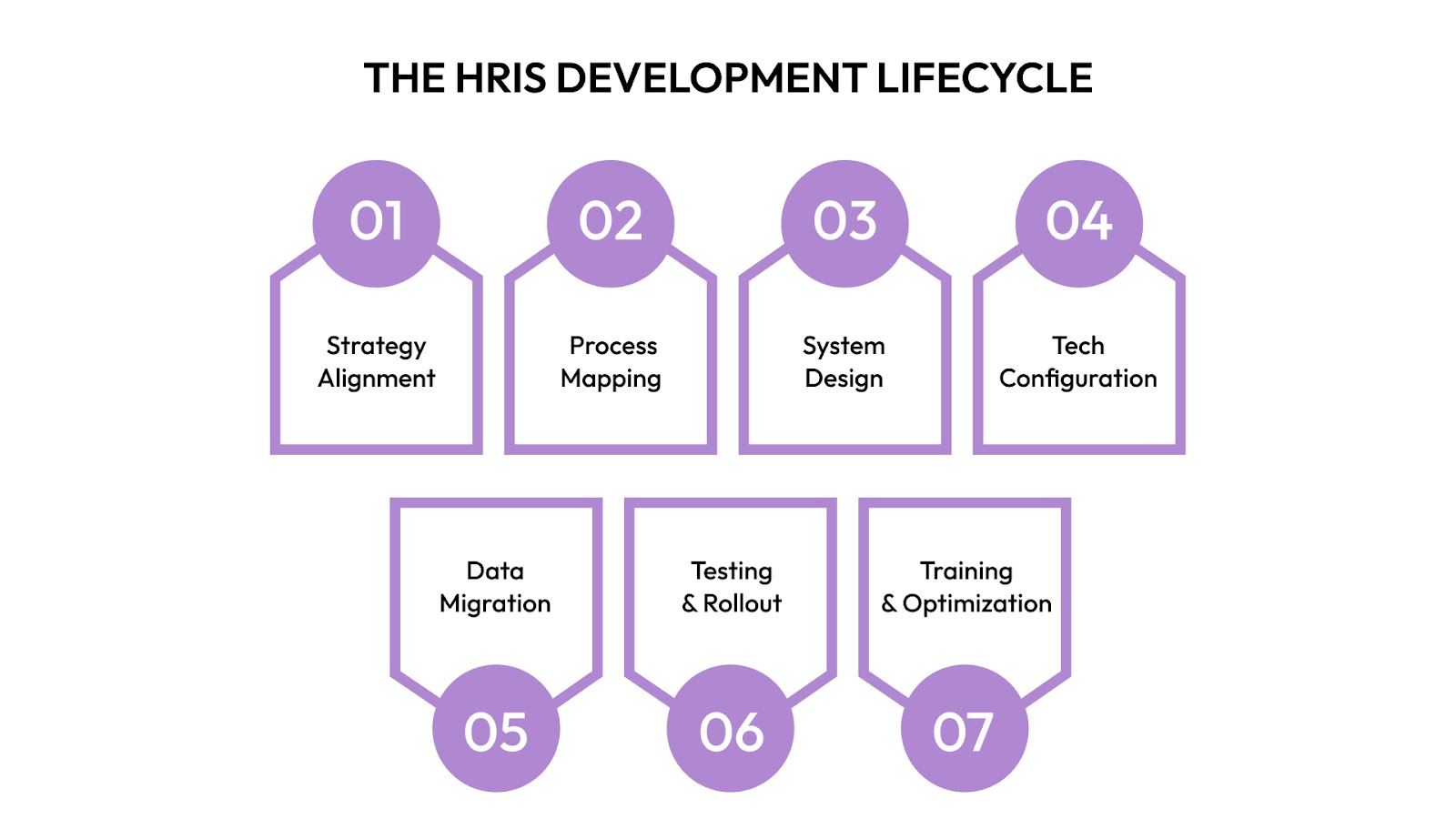
Building a robust HRIS is a strategic initiative that shapes how your organization scales, engages talent, and governs workforce data. Understanding the HRIS development lifecycle helps you minimize risk, maximize adoption, and align systems with your evolving business needs.
Phase 1: Strategy Alignment & Objective Setting
Before any tech decisions are made, align your HRIS development with business outcomes. Whether you're optimizing compensation workflows or preparing for global scale, clarity at this stage drives ROI.
Focus on:
- Defining measurable goals (e.g., reduce manual HR tasks by 60%)
- Engaging cross-functional stakeholders: HR, Finance, IT, and Operations
- Establishing governance structure and success metrics
Phase 2: Requirement Gathering & Process Mapping
This is where you analyze what’s broken and what’s possible.
Best practices:
- Audit existing workflows: from onboarding and comp cycles to headcount requests
- Identify bottlenecks and manual dependencies
- Outline must-have system capabilities (e.g., role-based access, compliance rules, modular integrations)
Tools like CandorIQ streamline this phase by helping define comp-related modules early in the process.
Phase 3: System Design & Architecture Planning
With requirements in hand, design a flexible architecture that supports future growth and integrations.
Key considerations:
- Modular design to support scalable workflows
- API readiness for integrations with ATS, payroll, CandorIQ, and finance tools
- Data security frameworks and compliance (GDPR, SOC2)
A rigid system today will become your liability tomorrow.
Phase 4: Development & Configuration
This is where strategy becomes reality. Whether you're building from scratch or customizing off-the-shelf solutions, development should be iterative.
Ensure your team:
- Prioritizes UX for HRBPs, managers, and employees
- Configures workflows for core modules (e.g., employee profiles, compensation, performance)
- Builds for adaptability like future comp benchmarking or AI-driven decision support
Phase 5: Data Migration & Integration
Clean data is the lifeblood of a successful HRIS. Migration isn’t just technical but foundational.
Key actions:
- Standardize formats across legacy systems
- Clean duplicates, incomplete records, and outdated fields
- Integrate real-time data feeds (e.g., CandorIQ for comp analytics and cycle planning)
Phase 6: Testing & Rollout
No system should go live without rigorous testing. You’re not just testing software, you’re validating process alignment.
Steps include:
- Unit, integration, and UAT (User Acceptance Testing)
- Pilots by department or function (start with HR, then scale)
- Finalizing escalation paths for technical and workflow issues
Phase 7: Training, Support & Optimization
A successful launch doesn’t end with go-live. It scales with your business.
Best practices:
- Develop training by user type (HR, finance, people managers)
- Create internal knowledge hubs
- Monitor adoption and iterate based on feedback
Integrate insights from CandorIQ to continually evolve workforce planning, comp governance, and retention efforts through your HRIS.
By approaching each phase with precision and purpose, you position your HRIS not as a tool, but as a strategic enabler that powers people operations, aligns with growth goals, and unlocks actionable workforce intelligence.

CandorIQ’s Role in Enhancing HRIS Development
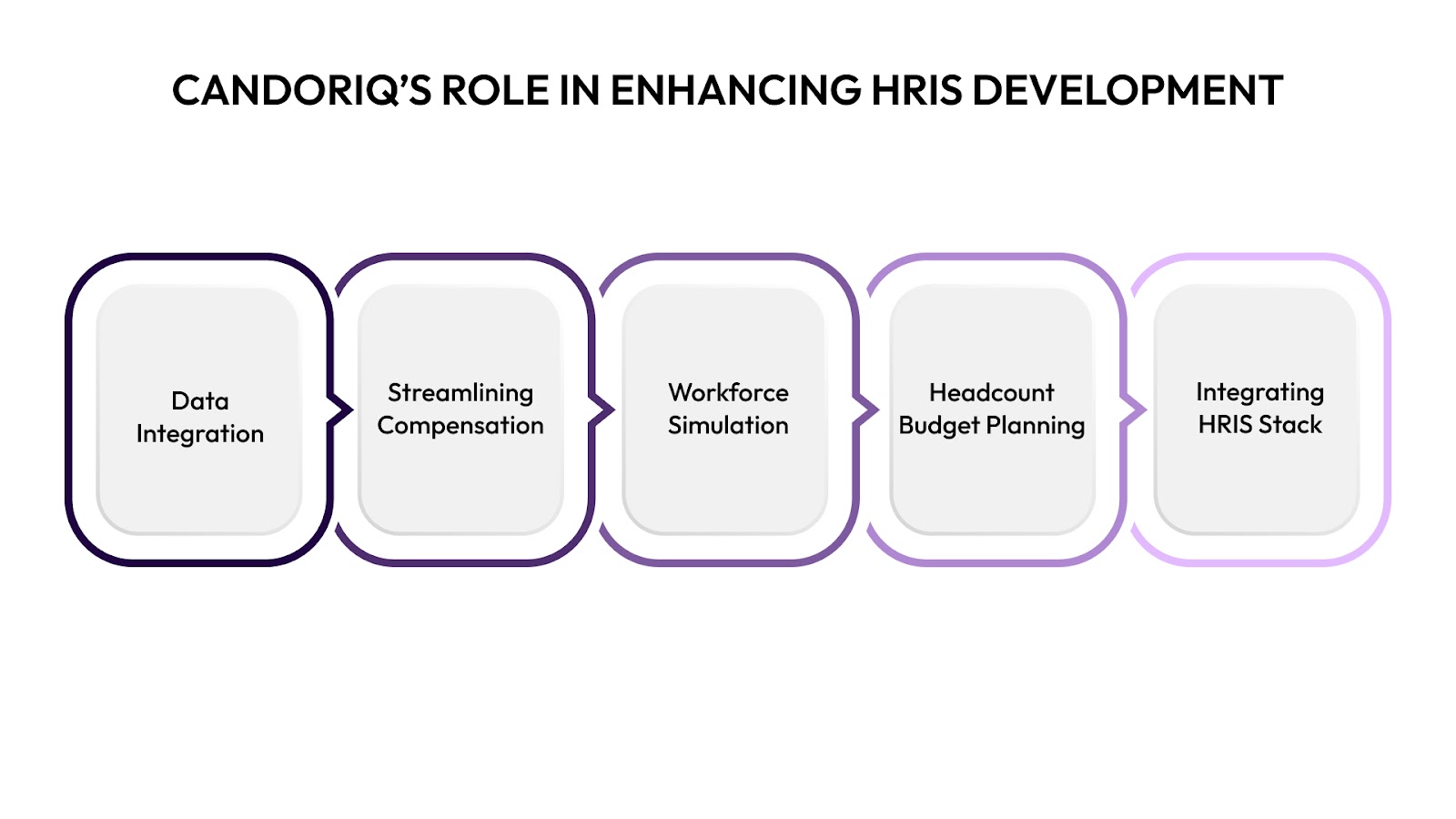
A modern HRIS must do more than store data, it should drive decisions, streamline planning, and proactively address workforce risks. That’s where CandorIQ adds strategic depth. Rather than functioning as a standalone layer, CandorIQ enhances your HRIS by embedding compensation intelligence, headcount planning, and attrition forecasting directly into your operational workflows.
1. Unifying People and Financial Data for Strategic Planning
Most HRIS platforms manage core records, but fall short on strategic planning. CandorIQ bridges that gap.
With CandorIQ, you can:
- Consolidate compensation, HR, and finance data into one cohesive view
- Surface trends across performance, pay equity, budget impact, and turnover
- Align talent investments with business outcomes, not just administrative needs
2. Streamlining Compensation Governance
Manual spreadsheets and fragmented tools can’t scale your comp processes. CandorIQ integrates directly with your HRIS to bring transparency and structure to every stage of the compensation cycle.
Key features include:
- Pre-configured compensation bands aligned to role, level, and location
- Real-time benchmarking against internal and external data
- Automated workflows for approvals, exceptions, and budget guardrails
3. Enabling Predictive Attrition and Workforce Scenario Modeling
HRIS systems track exits, CandorIQ predicts them. By analyzing behavioral signals, compensation trends, and performance data, you gain foresight into team stability.
CandorIQ equips you to:
- Identify high-risk roles and departments before attrition spikes
- Model “what-if” headcount scenarios with financial impact
- Prioritize retention investments in your most critical segments
4. Powering Agile Headcount and Budget Planning
Your HRIS shows current headcount. CandorIQ helps you plan for what’s next.
Use CandorIQ to:
- Align approved roles with forecasted budgets
- Compare plan vs. actuals in real time across departments
- Run hiring simulations based on performance targets and runway
5. Integrating Seamlessly with Your HRIS Stack
CandorIQ was built for interoperability. Whether you use Workday, BambooHR, SuccessFactors, or another HRIS, integration is seamless, with no disruption to existing workflows.
Benefits include:
- Plug-and-play data sync across HR, finance, and performance systems
- Secure API integrations with automated updates
- Minimal IT involvement with maximum visibility for HR leaders
By embedding CandorIQ into your HRIS development strategy, you don’t just digitize HR, you elevate it. You gain a data-rich foundation that supports everything from strategic comp decisions to proactive workforce shaping, helping your organization stay resilient and future-ready.
Key Success Metrics to Track in HRIS Development
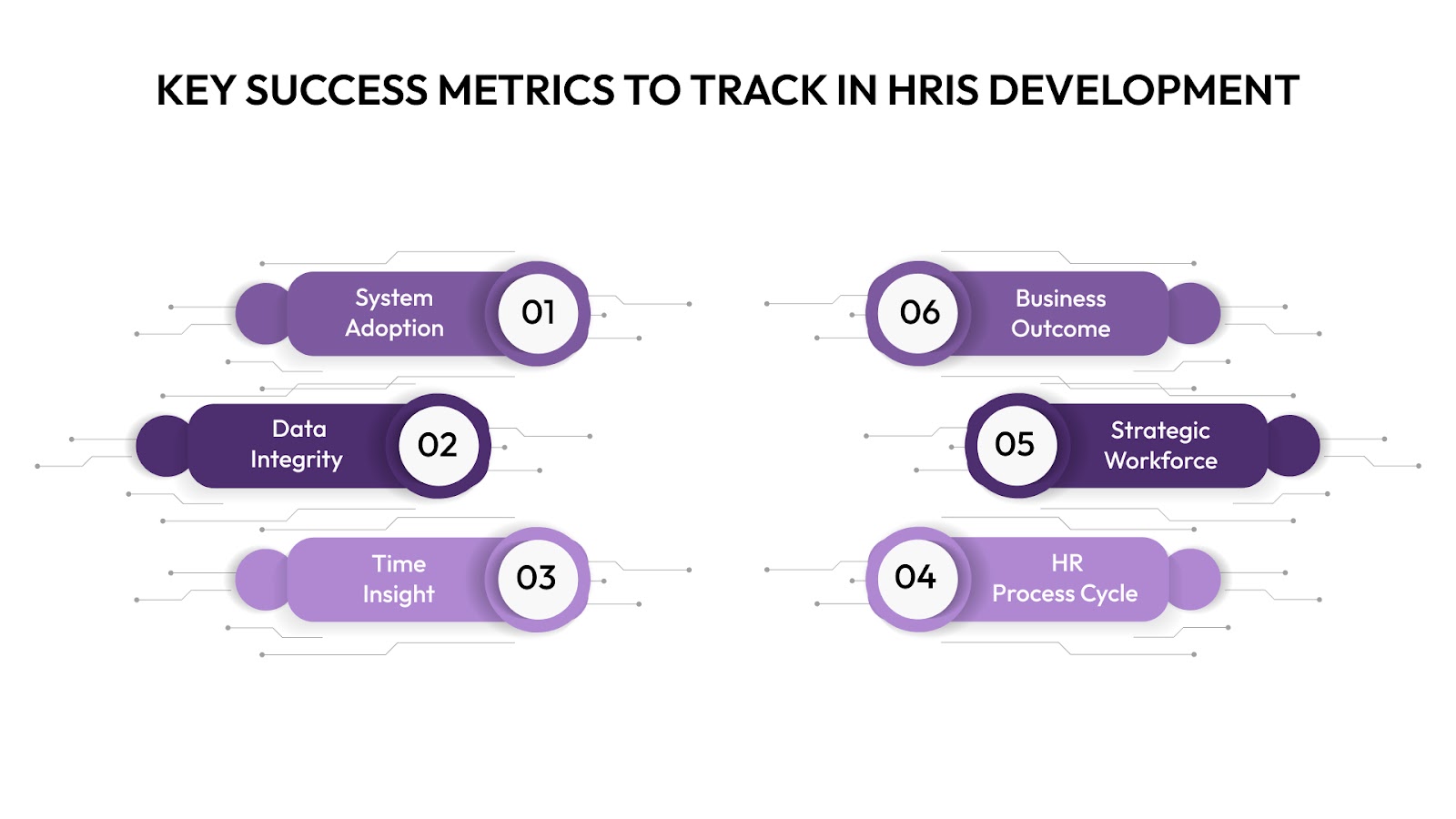
Implementing or modernizing an HRIS is a significant investment, but without the right success metrics, you won’t know if it’s driving real business value. By tracking specific KPIs aligned with strategic goals, you can gage the effectiveness of your HRIS and ensure it supports smarter workforce decisions, increased efficiency, and better alignment between HR and finance.
1. System Adoption and Usage Rates
You can’t optimize what people don’t use. Start by measuring how widely and effectively your HRIS is being adopted.
Track:
- User adoption rate by role (e.g., HR, managers, employees)
- Daily/monthly active users
- Completion rates of tasks like performance reviews, compensation submissions, or approvals
2. Data Quality and Integrity
A system is only as powerful as the data it houses. Poor data quality leads to bad decisions and wasted resources.
Key metrics include:
- Error rate in employee records and transactions
- Percentage of complete employee profiles
- Frequency of duplicate or outdated entries
- Time to resolve data discrepancies
3. Time-to-Insight
The speed at which your HR and business teams can extract actionable insights from the system matters, especially for decision-making around compensation, attrition, and workforce planning.
Measure:
- Time taken to generate reports or dashboards
- Number of manual report requests vs. self-service usage
- Average time to identify and act on key workforce trends
4. HR Process Cycle Times
One of the most tangible benefits of a modern HRIS is automation. You should measure the reduction in manual cycles and administrative lag.
Metrics to track:
- Compensation cycle time (planning to approval)
- Onboarding and offboarding turnaround
- Time-to-fill open roles
- Performance review completion time
5. Strategic Workforce Insights Enabled
This is where CandorIQ enhances traditional HRIS metrics. Beyond operational KPIs, track your ability to surface and act on workforce trends.
Monitor:
- Attrition prediction accuracy
- Cost per hire vs. plan
- Pay equity and compensation benchmarking outcomes
- Forecasting accuracy for headcount and budget planning
6. Business Outcome Alignment
Ultimately, HRIS success should map to broader organizational goals.
Tie your metrics to:
- Revenue per employee
- Manager satisfaction with workforce data
- Reduction in regrettable attrition
- HR-to-employee ratio improvements
By tracking these strategic and operational metrics, you ensure your HRIS investment isn’t just a technology upgrade but a business accelerator. With platforms like CandorIQ, you gain the added benefit of real-time visibility into workforce costs, risks, and performance, so every metric moves you closer to your growth targets.
Future Trends & HRIS Evolution: What Business Leaders Should Prepare For
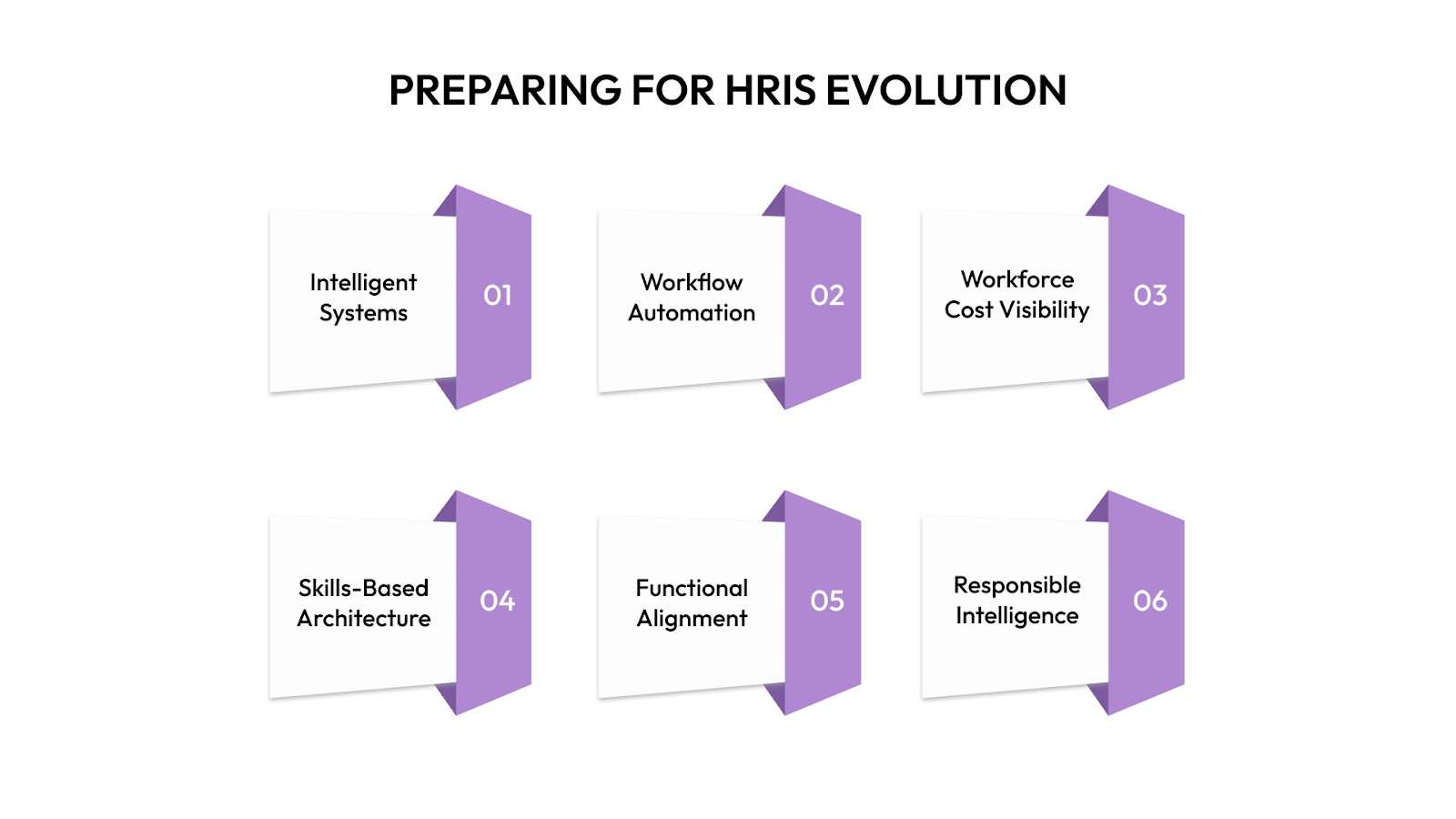
As business models evolve and the workplace becomes increasingly data-driven, so does the role of HRIS. Here’s what you, as a business executive, need to anticipate.
1. From System of Record to System of Intelligence
Traditional HRIS platforms focused on storing employee data. But now, you're expected to do more with that data, forecast attrition, optimize comp, and inform org design.
Trend to watch:
- Embedded predictive analytics will become standard, not optional.
- HRIS platforms are integrating scenario modeling and simulation tools for headcount, pay equity, and skills forecasting.
2. AI Agents and Workflow Automation
The next-gen HRIS will be powered by intelligent automation, shifting repetitive, rules-based tasks to AI agents and freeing your HR team for strategic work.
What this means for you:
- AI-powered agents will handle comp reviews, alerts for pay equity gaps, employee sentiment scans, and real-time org health summaries.
- Expect event-triggered workflows: e.g., when a high-performing employee is flagged as a flight risk, HRIS will trigger retention workflows instantly.
3. Real-Time Compensation and Workforce Cost Visibility
Compensation is no longer an annual planning event. With inflation, hybrid work, and DEI demands, it's dynamic—and your HRIS must adapt.
Upcoming innovations include:
- Live pay benchmarking tools
- Automated pay equity auditing
- Integrated compensation governance across teams and countries
Platforms like CandorIQ already lead here, offering cross-system visibility into workforce costs, budgets, and comp risks in real time.
4. Skills-Based Architecture
Future-ready HRIS systems are moving beyond roles and titles to a skills-based framework, vital for agile workforce planning and internal mobility.
You’ll need:
- Skills taxonomies integrated into employee profiles
- Analytics that match emerging business needs with internal skills
- Visualization tools to spot gaps and guide upskilling investments
5. Stronger HR–Finance–Operations Convergence
The future HRIS won't operate in a silo. It’ll be a shared planning tool across departments, informing financial planning, budgeting, and operational strategy.
Shift to expect:
- Integrated workforce and financial forecasting
- Unified dashboards for CHROs, CFOs, and COOs
- Real-time updates to reflect changes in hiring, attrition, or performance
6. Compliance and Ethical AI as Core Capabilities
As regulations tighten and transparency becomes a mandate, your HRIS must build in controls to ensure ethical data use and regulatory compliance.
What’s evolving:
- Built-in compliance rules for pay transparency, DEI metrics, and AI bias audits
- Audit trails for comp decisions and headcount changes
- Region-specific privacy features (e.g., GDPR, India DPDP Act)
Upgrading your software means building a smarter, more flexible organization. Future-ready HRIS platforms like CandorIQ help you lead the shift.
Now’s the time to:
- Audit your current HRIS capabilities
- Identify gaps in forecasting, analytics, and automation
- Build a roadmap to modernize with flexibility and future-proofing in mind
The evolution is here. Your workforce strategy depends on whether you’re ready to meet it.

Conclusion
The development of HRIS is no longer a back-office project, it’s a business-critical initiative that impacts workforce productivity, financial performance, and strategic agility. To stay competitive, you need more than just a system that stores employee data. You need a platform that helps you analyze, optimize, and act, in real time.
Ready to turn your HR system into a strategic powerhouse? CandorIQ empowers you with intelligent insights, seamless integrations, and actionable analytics to elevate your HRIS strategy.
Book a demo today and see how CandorIQ can accelerate your digital HR transformation.


